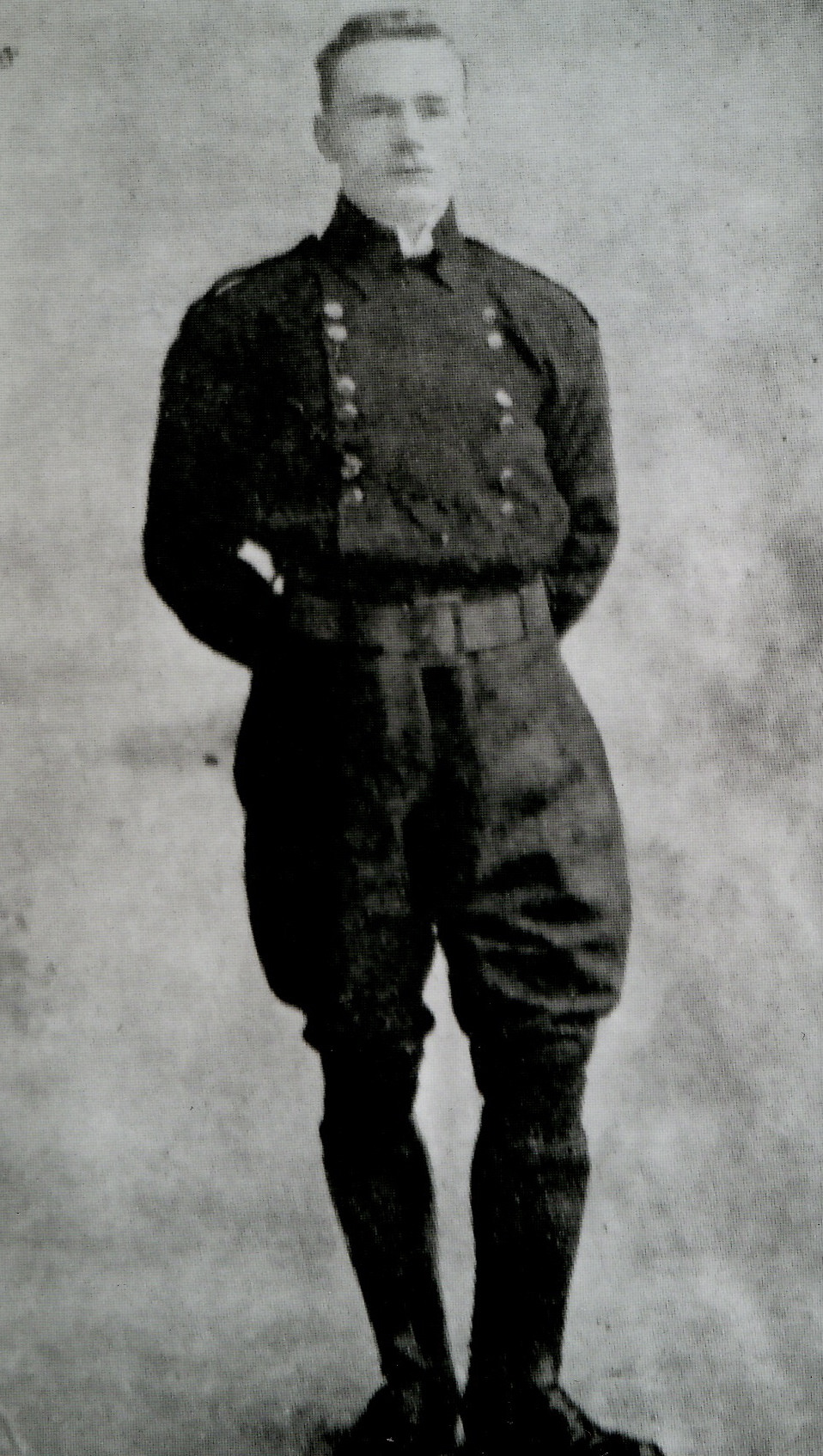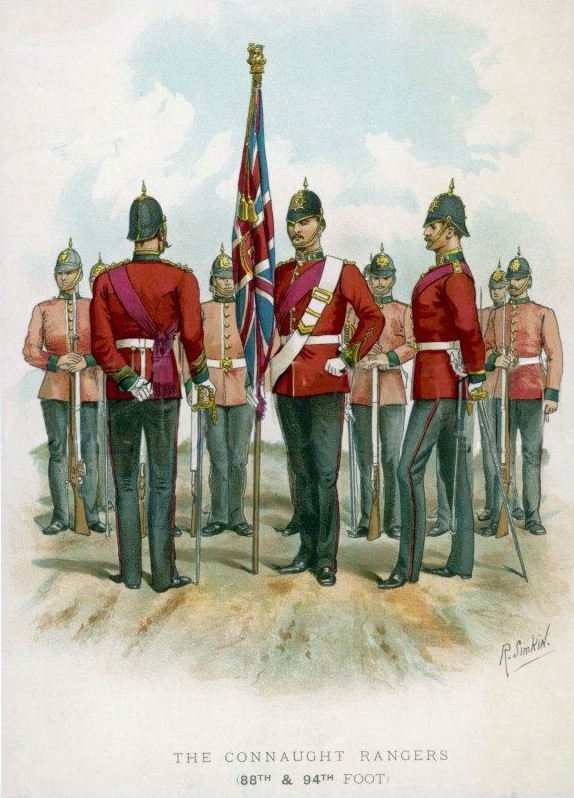|
Renmore Barracks
Renmore Barracks ( ga, Dún Uí Mhaoilíosa) is a military installation in Renmore, Ireland History The barracks were built by Colleran Brothers, a Dublin-based contractor, and completed in 1881. Their creation took place as part of the Cardwell Reforms which encouraged the localisation of British military forces. The barracks became the depot for the 87th (Royal Irish Fusiliers) Regiment of Foot and the 88th Regiment of Foot (Connaught Rangers). Following the Childers Reforms, the 88th Regiment of Foot (Connaught Rangers) and 94th Regiment of Foot amalgamated to form the Connaught Rangers with its depot in the barracks in 1881. The Connaught Rangers was disbanded at the time of Irish Independence in 1922. The barracks were taken over by the Irish Army at that time and then renamed Dún Uí Mhaoilíosa after Liam Mellows, an Irish Republican, in 1952. The barracks are now home to the 1st Infantry Battalion. Dún Uí Mhaoilíosa Museum Renmore Barracks features a museum that ... [...More Info...] [...Related Items...] OR: [Wikipedia] [Google] [Baidu] |
Renmore
Renmore () is a suburb of Galway City, Ireland, situated approximately 2 km to the east of the city. Renmore runs east along the coast and south of Dublin Road, from the shore of Lough Atalia on its west side to Lurgan Park on its east. The area houses approximately 5,000 people and includes Ballyloughane beach, which also has camping facilities. Amenities Lough Atalia lies between Renmore and the city, which can be crossed using the public path beside the railway line (widely known as 'the line'). St Oliver Plunkett Church is located beside the local national (primary) school. The primary school in Renmore is known as ''Scoil Chaitriona'', and there is also an all-Irish gaelscoil named ''Gaelscoil Dara''. Galway-Mayo Institute of Technology is one of the larger employers in the area. Renmore is also home to Dún Uí Mhaoilíosa (meaning "Mellow's Fort" and named for Liam Mellows), a base of the Irish Army's Southern Brigade. The barracks, also officially and commonly k ... [...More Info...] [...Related Items...] OR: [Wikipedia] [Google] [Baidu] |
94th Regiment Of Foot
The 94th Regiment of Foot was a British Army line infantry regiment, raised as the Scotch Brigade in October 1794. It was renumbered as the 94th Regiment of Foot in December 1802 and disbanded in December 1818. The regiment was reformed in December 1823 and served until 1881 when it amalgamated with the 88th Regiment of Foot to form the Connaught Rangers. History Formation The regiment was raised, from officers who had previously served in the Scots Brigade, by General Francis Dundas as the Scotch Brigade on 9 October 1794.Historical record, p. 246 The regiment embarked for Gibraltar in November 1795Historical record, p. 248 and then moved on to South Africa in 1796 before transferring to India in late 1798. The regiment landed at Madras in January 1799 and saw action at the Battle of Mallavelly in March 1799Historical record, p. 249 and the siege of Seringapatam in April 1799 during the Fourth Anglo-Mysore War.Historical record, p. 251 It was renumbered as the 94th Regiment o ... [...More Info...] [...Related Items...] OR: [Wikipedia] [Google] [Baidu] |
Boyle, County Roscommon
Boyle (; ) is a town in County Roscommon, Ireland. It is located at the foot of the Curlew Mountains near Lough Key in the north of the county. Carrowkeel Megalithic Cemetery, the Drumanone Dolmen and the lakes of Lough Arrow and Lough Gara are also close by. , the population of the town was 2,568. History Early history On 15 August 1599, the Battle of Curlew Pass between English and Irish forces was fought in the Curlew mountains during the Nine Years' War, between an English force under Sir Conyers Clifford and a native Irish force led by Aodh Ruadh Ó Domhnaill (Red Hugh O'Donnell). The English were ambushed and routed while marching through a pass in the Curlew Mountains, with the English forces suffering heavy casualties. Losses by allied Irish forces were not recorded. The Queen's principal secretary, Sir Robert Cecil, rated this defeat (and the simultaneous defeat of Harrington in Wicklow) as the two heaviest blows suffered by the English in Ireland. Boyle suffered har ... [...More Info...] [...Related Items...] OR: [Wikipedia] [Google] [Baidu] |
Infantry Corps (Ireland)
, image= Defense Forces Infantry Flag (Ireland).svg , image_size = 200 , caption=Flag of the Irish Army Infantry Corps , dates=1 October 1924 – present , country= , branch= , command_structure= [...More Info...] [...Related Items...] OR: [Wikipedia] [Google] [Baidu] |
Irish Republicanism
Irish republicanism ( ga, poblachtánachas Éireannach) is the political movement for the unity and independence of Ireland under a republic. Irish republicans view British rule in any part of Ireland as inherently illegitimate. The development of nationalist and democratic sentiment throughout Europe in the eighteenth and nineteenth centuries, distilled into the contemporary ideology known as republican radicalism, was reflected in Ireland in the emergence of republicanism, in opposition to British rule. Discrimination against Catholics and Protestant nonconformists, attempts by the British administration to suppress Irish culture, and the belief that Ireland was economically disadvantaged as a result of the Acts of Union were among the specific factors leading to such opposition. The Society of United Irishmen, formed in 1791 and led primarily by liberal Protestants, launched the 1798 Rebellion with the help of troops sent by Revolutionary France, but the uprising f ... [...More Info...] [...Related Items...] OR: [Wikipedia] [Google] [Baidu] |
Liam Mellows
William Joseph Mellows ( ga, Liam Ó Maoilíosa, 25 May 1892 – 8 December 1922) was an Irish republican and Sinn Féin politician. Born in England to an English father and Irish mother, he grew up in Ashton-under-Lyne before moving to Ireland, being raised in Cork, Dublin and his mother's native Wexford. He was active with the Irish Republican Brotherhood and Irish Volunteers, and participated in the Easter Rising in County Galway and the War of Independence. Elected as a TD to the First Dáil, he rejected the Anglo-Irish Treaty. During the Irish Civil War Mellows was captured by Pro-Treaty forces after the surrender of the Four Courts in June 1922. On 8 December 1922 he was one of four senior IRA men executed by the Provisional Government. Early life Mellows was born at the Hartshead Military Barracks in Ashton-under-Lyne on 25 May 1892, the son of William Joseph Mellows, an English man who worked as an NCO in the British Army, and Sarah Jordan, an Irish woman from Inch, Co ... [...More Info...] [...Related Items...] OR: [Wikipedia] [Google] [Baidu] |
South Irish Horse
The South Irish Horse was a Special Reserve cavalry regiment of the British Army. Formed as an Imperial Yeomanry regiment in 1902 as the South of Ireland Imperial Yeomanry, it perpetuated a unit formed during the Second Boer War. It transferred to the Special Reserve (Cavalry) in 1908 and was renamed as the South Irish Horse. Having taken part in the fighting of World War I, it was disbanded after Irish Independence in 1922. Imperial Yeomanry Following a string of defeats during Black Week in early December 1899, the British government realised that it would need more troops than just the Regular Army to fight the Second Boer War, particularly mounted units. On 13 December, the War Office decided to allow volunteer forces to serve in the field, and a Royal Warrant was issued on 24 December that officially created the Imperial Yeomanry (IY). This was organised as service companies of approximately 115 men enlisted for one year. They were equipped to operate as Mounted infantry, ar ... [...More Info...] [...Related Items...] OR: [Wikipedia] [Google] [Baidu] |
Anglo-Irish Treaty
The 1921 Anglo-Irish Treaty ( ga , An Conradh Angla-Éireannach), commonly known in Ireland as The Treaty and officially the Articles of Agreement for a Treaty Between Great Britain and Ireland, was an agreement between the government of the United Kingdom of Great Britain and Ireland and representatives of the Irish Republic that concluded the Irish War of Independence. It provided for the establishment of the Irish Free State within a year as a self-governing dominion within the "community of nations known as the British Empire", a status "the same as that of the Dominion of Canada". It also provided Northern Ireland, which had been created by the Government of Ireland Act 1920, an option to opt out of the Irish Free State (Article 12), which the Parliament of Northern Ireland exercised. The agreement was signed in London on 6 December 1921, by representatives of the British government (which included Prime Minister David Lloyd George, who was head of the British delegates) ... [...More Info...] [...Related Items...] OR: [Wikipedia] [Google] [Baidu] |
Connaught Rangers
The Connaught Rangers ("The Devil's Own") was an Irish line infantry regiment of the British Army formed by the amalgamation of the 88th Regiment of Foot (Connaught Rangers) (which formed the ''1st Battalion'') and the 94th Regiment of Foot (which formed the ''2nd Battalion'') in July 1881. Between the time of its formation and Irish independence, it was one of eight Irish regiments raised largely in Ireland. Its home depot was in Galway.Harris, Appendix II, pp. 216–217: Table listing the eight Irish Regiments of the British Army July 1914, their Depots, Reserve Bns., and local Militia.: Royal Irish Regiment Depot Clonmel, Royal Inniskilling Fusiliers Depot Omagh, Royal Irish Rifles Depot Belfast, Royal Irish Fusiliers (Princess Victoria's) Depot Armagh, Connaught Rangers Depot Galway, Leinster Regiment Depot Birr, Royal Munster Fusiliers Depot Tralee, Royal Dublin Fusiliers Depot Naas. It was disbanded following the establishment of the independent Irish Free State in 1922, a ... [...More Info...] [...Related Items...] OR: [Wikipedia] [Google] [Baidu] |
Childers Reforms
The Childers Reforms of 1881 reorganised the infantry regiments of the British Army. The reforms were done by Secretary of State for War Hugh Childers during 1881, and were a continuation of the earlier Cardwell Reforms. The reorganisation was effected by General Order 41/1881, issued on 1 May 1881, amended by G.O. 70/1881 dated 1 July, which created a network of multi-battalion regiments. In England, Wales and Scotland, each regiment was to have two regular or "line" battalions and two Militia (United Kingdom), militia battalions. In Ireland, there were to be two line and three militia battalions. This was done by renaming the numbered regiments of foot and county militia regiments. In addition, the various corps of county Volunteer Force (Great Britain), rifle volunteers were to be designated as volunteer battalions. Each of these regiments was associated by headquarters location and territorial name to its local "Regimental District". The reforms became effective on 1 July. F ... [...More Info...] [...Related Items...] OR: [Wikipedia] [Google] [Baidu] |
Galway
Galway ( ; ga, Gaillimh, ) is a City status in Ireland, city in the West Region, Ireland, West of Ireland, in the Provinces of Ireland, province of Connacht, which is the county town of County Galway. It lies on the River Corrib between Lough Corrib and Galway Bay, and is the List of settlements on the island of Ireland by population, sixth most populous city on the island of Ireland and the List of urban areas in the Republic of Ireland by population, fourth most populous in the Republic of Ireland, with a population at the 2022 census of Ireland, 2022 census of 83,456. Located near an earlier settlement, Galway grew around a fortification built by the Kings of Connacht, King of Connacht in 1124. A municipal charter in 1484 allowed citizens of the by then walled city to form a Galway City Council, council and mayoralty. Controlled largely by a group of merchant families, the Tribes of Galway, the city grew into a trading port. Following a period of decline, as of the 21st ... [...More Info...] [...Related Items...] OR: [Wikipedia] [Google] [Baidu] |








